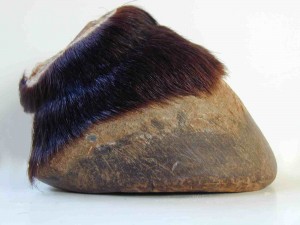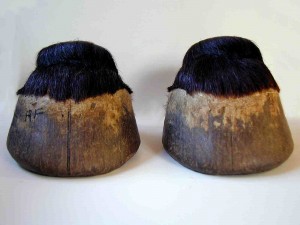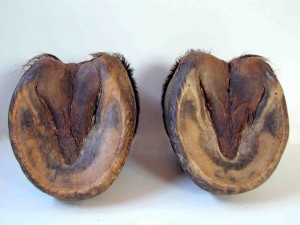Archive for the ‘Horses Health’ Category
How to check a horse’s vital signs
Vital Signs
By Cheryl Sutor
If you own, ride or handle horses, it is mandatory that you educate yourself of taking care of them. You will need to know at some point, how to tell if a horse is feeling well, or if a horse needs immediate veterinary attention. A horse’s vital signs should be checked regularly, once a week is ideal. Check the horse’s vital signs every time you suspect any change in his behavior. Learning to accurately observe and judge your horse’s vital signs takes alot of practice. Your horse is counting on you to find and treat every problem or illness in its early stages!
If ANY concern arises, never hesitate to call your veterinarian!
1. TEMPERATURE
Normal body temperature is 99 – 101 F. A temperature higher than that, may indicate an infection. A healthy horse’s temperature can vary by 3 degrees depending on environmental factors. Horses tend to have higher temperatures in warm weather and during/after exercise, stress or excitement. A high fever doesn’t Read the rest of this entry »
How to Feed a Starving Horse
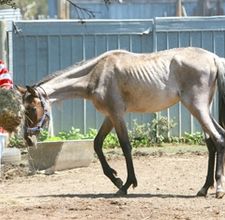 We have recently taken an older horse into our care who was retired from work due to his declining health. He was unable to live in a herd enviroment and fend for himself anymore and so he has come to us so that he can recieve personalized care and feeding.
We have recently taken an older horse into our care who was retired from work due to his declining health. He was unable to live in a herd enviroment and fend for himself anymore and so he has come to us so that he can recieve personalized care and feeding.
Although this horse came from a good home and was by no means a ‘rescue’ it did make me think about all the rescue horses that we have nursed back to health and what a difficult and long journey it can be.
Taking in and bringing a starving horse back to health should always be approached with adequate information and preperation for the task ahead and this article helps you to understand a little of what this involves…
—————————————————
If a malnourished horse has come under your care, it is important you know that feeding him is delicate. The horse’s stomach is a fragile organ, prone to distension and colic and other problems, so you have to carefully monitor the feed a malnourished horse receives, and make adjustments accordingly.
Instructions
ONE—-It is a sight that is far too common these days–horses starved to the point of death or near death. If you are kind enough to try and help, remember that no good deed is easy, and often you will find yourself wondering why on earth you got yourself into this mess. Read the rest of this entry »
How to Make Natural, Safe Insect Repellents for Your Horses
Mosquitoes are not just pests for humans. They will pierce any living creature that has blood flowing through its body. Mosquitoes can carry a variety of diseases, including encephalitis and malaria. If you own any horses it is a good idea to coat them with a mosquito repellent, but you don’t need to purchase a mosquito repellent that is full of harsh chemicals.
MOSQUITO SPRAY FOR HORSES
1- Place 16 oz. of vodka in an empty spray bottle. This is the base of your homemade horse mosquito repellent.
2- Add 1/2 oz. of citronella oil, 1/4 oz. of lavender oil, Read the rest of this entry »
A Herbalists Perspective: The Care and Management of the Laminitic and Insulin resistant Horse or Pony
By Catherine McDowell
Spring is with us, and so is the dreaded laminitis! Over the last 2 weeks Herbal Treatments staff have been inundated with requests for information and treatment of the laminitic horse or pony.
Step 1: Day 1
Remove the cause of the laminitis
Green grass (especially from fresh small fast growing grasses) is critical. Do not re-introduce the horse or pony to pasture until you have full knowledge of the degree of the condition. Do not feed Lucerne hay.
Feed 3 hour soaked dry grass hay or oaten hay, Speedi-beet and appropriate herbs.
Weight must be reduced and appropriate feeds given to restore metabolic harmony. A natural mineral supplement with a magnesium and chromium supplement is advised here. We at herbal treatments prefer Khonkes Mag E and Life Springs Colloidal Minerals or Seaweed (kelp). Do not fast (starve) your pony or horse for longer than 12 hours. Read the rest of this entry »
Spring Grass and Pro-Biotics
by Marijke van de Water, B.Sc., DHMS
Spring Grass and Probiotics

HEALTHY HORSE TREAT RECIPES
Making homemade horse treats is one way to make sure that your horse is getting yummy treats with fresh and healthy ingredients straight from your kitchen. Mix up some healthy horse cookies and replace those sugar cubes in your pocket with something more nutritious. Read on to learn how to make healthy horse treats.
Oat ‘n’ Apple Chewies
INGREDIENTS: Read the rest of this entry »
CARING FOR YOUR OLDER HORSE
How is looking after an old horse different from caring for other horses?
As a horse ages, his bodily functions become less efficient. His teeth may deteriorate to the point where he can’t graze properly or chew his hay. He may be arthritic. With less fat cover, he has more trouble keeping himself warm. Such things as good shelter, routine worming and regular dental care, which were important when the horse was in his prime, now become vital.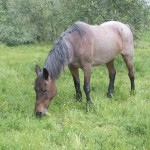
What kind of shelter does my horse need?
Remember that your horse is now a senior citizen. He needs protection from wind and wet. A dry, three sided shelter bedded with straw is a good choice. Some old horses might need to be brought into a barn when the weather is bad.
What do you mean by “routine dental care”?
The way a horse chews his food wears the teeth unevenly. Most horses Read the rest of this entry »
MUSTANG FEET
Mustang Feet
The Mustang is our best example of how healthy and hardy horses can be barefoot. Wild mustangs live on very hard ground, often extremely rocky ground. They also cover from 20-30 miles daily looking for food, water, and avoiding predators.
Mustangs have excellent hoof conformation with short heels, a dubbed toe, large frogs, and short bars. Mustangs are almost never seen with a hoof deformity or lameness.
However, our domestic horses ARE NOT mustangs. Not all horses live in arid rocky climates. A rider’s goals, their horse’s genetics and the boarding situation will make the difference in just how far an individual horse can go barefoot. A horse that is stalled the majority of the time may have problems living a barefoot lifestyle. Bare feet are natural, stalls are not.
Historically horses were ridden and used barefoot until a variety of husbandry changes occurred (stalling, diet, genetics) caused shoes to become necessary. Stabling conditions cause the feet to be exposed to extreme drying situations (bedding) which then became wet situations (soiled bedding) while minimizing hoof mechanism due to the restricted movement.
This leads to deterioration of the hoof wall and form, thus bringing about the practice of shoeing to keep them protected. The more turn out and exercise your horse gets the healthier their feet will be.
Horses that are primarily ridden in sandy arenas, or on soft trails may not need shoes. Horses that are ridden long distances on rocky or hard terrain will need more effort to ride barefoot, though it is often possible. Many disciplines will require shoeing for competitions or training as they are very different from what “wild horses do”.
For example, a reining horse will need shoes on the back feet in order to slide without abrading their back heels. Event horses who may jump large fences and make tight turns in mud often need shoes and removable studs for safety.
Barefeet have BETTER traction than shoes in most footing circumstances (rock, roads, firm ground). But when the mud is 6″ deep, there is no barefoot approach to over come it.
ARE YOU READY FOR ANOTHER WINTER?… IS YOUR HORSE? – Part 2…
Preparations
FEED
Know in advance what you are going to feed during the winter months. When first frost kills your summer pasture is not the time to decide on a winter feeding program and it can be detrimental to your horse.
Chances are the grass that he was feeding on was devoid in nutrient value and he was losing body condition. With less time to acclimate your horse to new feed sources, plus a declining body condition, you have lost valuable time to prepare your horse for more extreme weather.
When temperatures dip, the best heat source for your horse is extra hay. Read the rest of this entry »
Top 10 Most Poisonous Plants for Horses
Of the hundreds of toxic plants in North America, only a handful are likely to bring serious harm to horses. Here are the top 10 most poisonous ones to watch out for.
By the Editors of EQUUS magazine
Take a stroll through any pasture, and there among the grasses you’ll find any number of different plants. Small vines, broad-leafed weeds, some wildflowers you recognize–some you don’t. And, as disquieting as it may be to contemplate, the chances are pretty good that at least some are toxic to horses. Hundreds of poisonous plants grow in North America, and many are extremely common. “I defy anyone to tell me they have a pasture with zero poisonous plants,” says Jeffery Hall, DVM, PhD, a toxicologist at Utah State University.
The good news, of course, is that the vast majority of those plants pose little threat to horses. For one thing, most of them are unpalatable, and horses who are filling up on quality forage aren’t likely to spend a lot of time grazing on the few bitter leaves populating their pasture. Another factor that protects horses is their size–a 1,000-pound animal has to consume significantly higher quantities of most toxins than a smaller animal does to feel any effects. So, for the most part, as long as your horses are healthy and your pasture is in good shape, you have little to worry about.
horses who are filling up on quality forage aren’t likely to spend a lot of time grazing on the few bitter leaves populating their pasture. Another factor that protects horses is their size–a 1,000-pound animal has to consume significantly higher quantities of most toxins than a smaller animal does to feel any effects. So, for the most part, as long as your horses are healthy and your pasture is in good shape, you have little to worry about.
However, some plants are cause for concern either because even a curious nibble can spell doom or because repeated browsing over weeks or months can lead to serious illness and death. All are worth getting to know by sight–not only so you can eliminate them from your horsekeeping areas, but also so that you can avoid encounters with them in the woods, on the roadsides and along the waterways where you ride. According to Anthony Knight, BVSc, MRCVS, plant toxicologist from Colorado State University, these 10 plants are those most dangerous to horses in the United States:
1. Bracken fern (Pteridum aquilinum)
Also known as: brake fern, eagle fern Read the rest of this entry »


